Features
In the Reign of the Sun Kings
By ERIC A. POWELL
Thursday, November 19, 2020
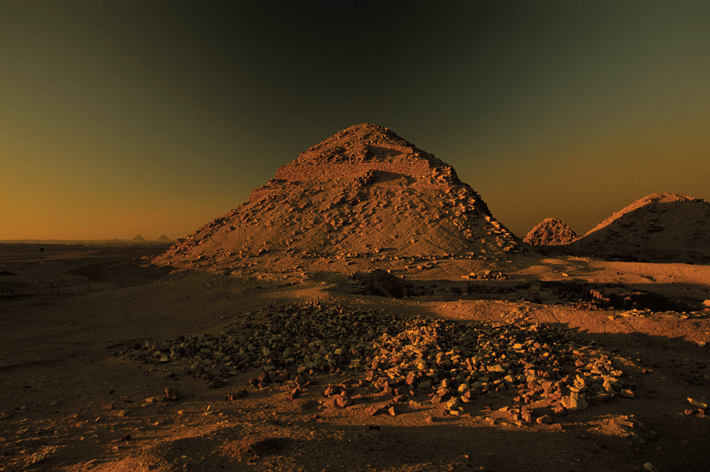 One of Egypt’s great vistas, says archaeologist Miroslav Bárta, is the view from the top of the pyramid of the 5th Dynasty pharaoh Neferirkare in the necropolis of Abusir. On a clear day, you can see all the iconic monuments of Egypt’s Old Kingdom from there. Ten miles to the north are the Great Pyramids of Giza. To the south rise the Bent Pyramid at Dashur and the great pyramid complex of Djoser in the nearby necropolis of Saqqara. This majestic tableau on the Nile’s west bank is the most visible legacy of the Old Kingdom pharaohs of the 3rd through 6th Dynasties, who reigned from about 2649 to 2150 B.C. and were celebrated throughout Egyptian history. The monarchs of the 3rd and 4th Dynasties oversaw the creation of the country’s most massive pyramids and loomed large in the Egyptian historical imagination. But Bárta, head of the Czech Institute of Egyptology’s Abusir Mission, says that the true legacy of the Old Kingdom lies in the momentous social changes that occurred during the reign of the 5th Dynasty pharaohs. Their relatively modest pyramids in the necropolis of Abusir may be somewhat overlooked by tour groups today, but the discoveries made by Czech teams there since the 1960s have shown how radical changes instituted during the 5th Dynasty irrevocably impacted the trajectory of Egyptian history. “Abusir tells the story of a time when Egypt changed utterly,” says Bárta.
One of Egypt’s great vistas, says archaeologist Miroslav Bárta, is the view from the top of the pyramid of the 5th Dynasty pharaoh Neferirkare in the necropolis of Abusir. On a clear day, you can see all the iconic monuments of Egypt’s Old Kingdom from there. Ten miles to the north are the Great Pyramids of Giza. To the south rise the Bent Pyramid at Dashur and the great pyramid complex of Djoser in the nearby necropolis of Saqqara. This majestic tableau on the Nile’s west bank is the most visible legacy of the Old Kingdom pharaohs of the 3rd through 6th Dynasties, who reigned from about 2649 to 2150 B.C. and were celebrated throughout Egyptian history. The monarchs of the 3rd and 4th Dynasties oversaw the creation of the country’s most massive pyramids and loomed large in the Egyptian historical imagination. But Bárta, head of the Czech Institute of Egyptology’s Abusir Mission, says that the true legacy of the Old Kingdom lies in the momentous social changes that occurred during the reign of the 5th Dynasty pharaohs. Their relatively modest pyramids in the necropolis of Abusir may be somewhat overlooked by tour groups today, but the discoveries made by Czech teams there since the 1960s have shown how radical changes instituted during the 5th Dynasty irrevocably impacted the trajectory of Egyptian history. “Abusir tells the story of a time when Egypt changed utterly,” says Bárta.
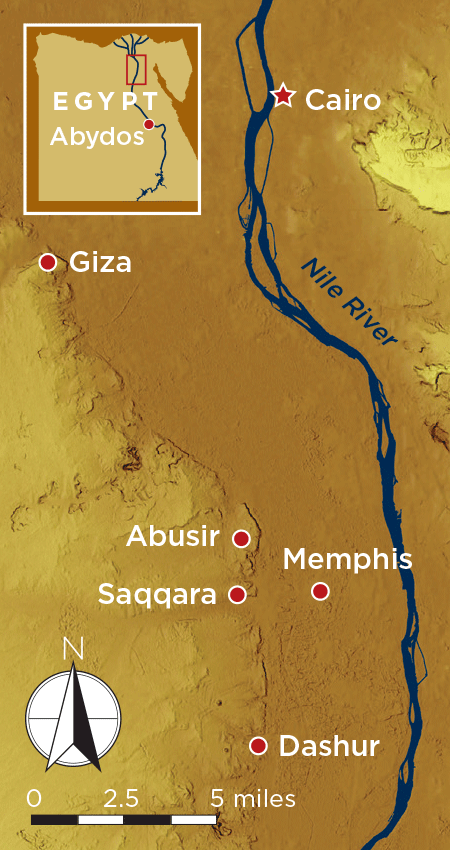 First built during the 3rd Dynasty near the newly established capital of Memphis, pyramids were symbols of the pharaohs’ unrivaled ability to command vast resources and labor. At least initially, the pyramid-building projects also seem to have contributed to an increasingly sophisticated bureaucracy and the spread of resources throughout the kingdom. “During the construction of the Great Pyramid, I would say that perhaps a quarter of the whole population profited from this single project,” says Bárta. By the end of the 4th Dynasty, though, these incredibly expensive royal constructions came close to bankrupting Egypt. The pharaohs of the 5th Dynasty not only inherited a precarious financial and political situation from their predecessors, whose profligate tastes in mortuary practices may have soured large segments of the Egyptian populace on the entire concept of royalty, they also came to power during a period when the climate was becoming increasing unstable. Decreased rainfall seems to have led to droughts, and the subsequent poor harvests threatened both the country’s prosperity and the royal tax revenue, which would have made the pharaohs’ hold on absolute power tenuous. The model that had held sway during earlier dynasties—that of power being invested in a single royal family—was not adequate to the challenges the 5th Dynasty pharaohs faced when they inherited the task of running an increasingly complex government. Suddenly, they found themselves compelled to share authority with a new class of non-royal officials.
First built during the 3rd Dynasty near the newly established capital of Memphis, pyramids were symbols of the pharaohs’ unrivaled ability to command vast resources and labor. At least initially, the pyramid-building projects also seem to have contributed to an increasingly sophisticated bureaucracy and the spread of resources throughout the kingdom. “During the construction of the Great Pyramid, I would say that perhaps a quarter of the whole population profited from this single project,” says Bárta. By the end of the 4th Dynasty, though, these incredibly expensive royal constructions came close to bankrupting Egypt. The pharaohs of the 5th Dynasty not only inherited a precarious financial and political situation from their predecessors, whose profligate tastes in mortuary practices may have soured large segments of the Egyptian populace on the entire concept of royalty, they also came to power during a period when the climate was becoming increasing unstable. Decreased rainfall seems to have led to droughts, and the subsequent poor harvests threatened both the country’s prosperity and the royal tax revenue, which would have made the pharaohs’ hold on absolute power tenuous. The model that had held sway during earlier dynasties—that of power being invested in a single royal family—was not adequate to the challenges the 5th Dynasty pharaohs faced when they inherited the task of running an increasingly complex government. Suddenly, they found themselves compelled to share authority with a new class of non-royal officials.
The necropolis of Abusir was the domain of most of the 5th Dynasty pyramids, but it is also densely packed with hundreds of other funeral monuments, including large rectangular tombs known as mastabas that held the remains of non-royal elites and testify to the growing social and political clout of this newly influential group, whose ranks included important priests and scribes. “It’s a story familiar to us today,” says Bárta. “A few families grew powerful and began to control more and more resources.” This new breed of official made their standing clear by commissioning lavish tombs close to those of the pharaohs. “There was a race for status,” says Bárta, one that included the pharaohs themselves, who had to find novel ways to compete with their newly potent subjects.
Alcohol Through the Ages
Friday, October 09, 2020
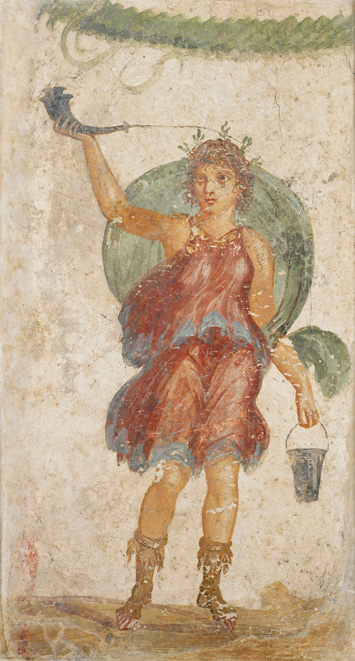 The happy accident of biting into a piece of fruit or sipping liquid imbued with the intoxicating properties imparted by fermentation must have beguiled innumerable early humans and their ancestors. At what point, however, did they first seek to control the process of alcoholic fermentation? A lump of beeswax wrapped in plant material and tied with twine discovered in South Africa’s Border Cave in 2012 suggests that early hunter-gatherers may have been making a type of honey-based alcohol there as long as 40,000 years ago. The bundle also contained traces of a protein substance, possibly egg, and tree resin—a recipe lost to time. This possible progenitor of a type of mead that is still made by the nomadic San peoples of South Africa may have been among a variety of new foods and technologies produced during the Paleolithic period.
The happy accident of biting into a piece of fruit or sipping liquid imbued with the intoxicating properties imparted by fermentation must have beguiled innumerable early humans and their ancestors. At what point, however, did they first seek to control the process of alcoholic fermentation? A lump of beeswax wrapped in plant material and tied with twine discovered in South Africa’s Border Cave in 2012 suggests that early hunter-gatherers may have been making a type of honey-based alcohol there as long as 40,000 years ago. The bundle also contained traces of a protein substance, possibly egg, and tree resin—a recipe lost to time. This possible progenitor of a type of mead that is still made by the nomadic San peoples of South Africa may have been among a variety of new foods and technologies produced during the Paleolithic period.
Since that time, people have never stopped seeking out new ways to enjoy their cocktails. However, alcoholic beverages, whether made from grapes or grain, have been sipped not only for pure enjoyment, but have also been used to nourish the dead and control empires, to establish trade relationships and manipulate the world economy, and sometimes just to eke out a living in tough times. For archaeologists, the consumption, creativity, and commerce associated with alcoholic beverages offers a unique window into one of humanity’s most popular pastimes.
Advertisement
DEPARTMENTS
Also in this Issue:
Advertisement
IN THIS ISSUE
Digs & Discoveries
Our Coastal Origins
Off the Grid
A Day by the Rhone
Painful Past
Miniature Masterpieces
Precision Instruments
Ship of Plenty
A Tale of Two Pipes
To Reach the Gods
Bronze Age Keepsakes
Honoring the Dead
Paleolithic Bedtime
Laurens' Last Stand
Piggy Playthings
What's in a Norse Name?
Around the World
Poison projectiles, Cortés’ Mexico City abode, Peruvian pelican fertilizer, and solving a Crusader mystery
Artifact
Turning over an old leaf
Advertisement

Recent Issues
-
 May/June 2024
May/June 2024
-
 March/April 2024
March/April 2024
-
 January/February 2024
January/February 2024
-
 November/December 2023
November/December 2023
-
 September/October 2023
September/October 2023
-
 July/August 2023
July/August 2023
-
 May/June 2023
May/June 2023
-
 March/April 2023
March/April 2023
-
 January/February 2023
January/February 2023
-
 November/December 2022
November/December 2022
-
 September/October 2022
September/October 2022
-
 July/August 2022
July/August 2022
-
 May/June 2022
May/June 2022
-
 March/April 2022
March/April 2022
-
 January/February 2022
January/February 2022
-
 November/December 2021
November/December 2021
-
 September/October 2021
September/October 2021
-
 July/August 2021
July/August 2021
-
 May/June 2021
May/June 2021
-
 March/April 2021
March/April 2021
-
 January/February 2021
January/February 2021
-
 November/December 2020
November/December 2020
-
 September/October 2020
September/October 2020
-
 July/August 2020
July/August 2020
-
 May/June 2020
May/June 2020
-
 March/April 2020
March/April 2020
-
 January/February 2020
January/February 2020
-
 November/December 2019
November/December 2019
-
 September/October 2019
September/October 2019
-
 July/August 2019
July/August 2019
-
 May/June 2019
May/June 2019
-
 March/April 2019
March/April 2019
-
 January/February 2019
January/February 2019
-
 November/December 2018
November/December 2018
-
 September/October 2018
September/October 2018
-
 July/August 2018
July/August 2018
-
 May/June 2018
May/June 2018
-
 March/April 2018
March/April 2018
-
 January/February 2018
January/February 2018
-
 November/December 2017
November/December 2017
-
 September/October 2017
September/October 2017
-
 July/August 2017
July/August 2017
-
 May/June 2017
May/June 2017
-
 March/April 2017
March/April 2017
-
 January/February 2017
January/February 2017
-
 November/December 2016
November/December 2016
-
 September/October 2016
September/October 2016
-
 July/August 2016
July/August 2016
-
 May/June 2016
May/June 2016
-
 March/April 2016
March/April 2016
-
 January/February 2016
January/February 2016
-
 November/December 2015
November/December 2015
-
 September/October 2015
September/October 2015
-
 July/August 2015
July/August 2015
-
 May/June 2015
May/June 2015
-
 March/April 2015
March/April 2015
-
 January/February 2015
January/February 2015
-
 November/December 2014
November/December 2014
-
 September/October 2014
September/October 2014
-
 July/August 2014
July/August 2014
-
 May/June 2014
May/June 2014
-
 March/April 2014
March/April 2014
-
 January/February 2014
January/February 2014
-
 November/December 2013
November/December 2013
-
 September/October 2013
September/October 2013
-
 July/August 2013
July/August 2013
-
 May/June 2013
May/June 2013
-
 March/April 2013
March/April 2013
-
 January/February 2013
January/February 2013
-
 November/December 2012
November/December 2012
-
 September/October 2012
September/October 2012
-
 July/August 2012
July/August 2012
-
 May/June 2012
May/June 2012
-
 March/April 2012
March/April 2012
-
 January/February 2012
January/February 2012
-
 November/December 2011
November/December 2011
-
 September/October 2011
September/October 2011
-
 July/August 2011
July/August 2011
-
 May/June 2011
May/June 2011
-
 March/April 2011
March/April 2011
-
 January/February 2011
January/February 2011
Advertisement





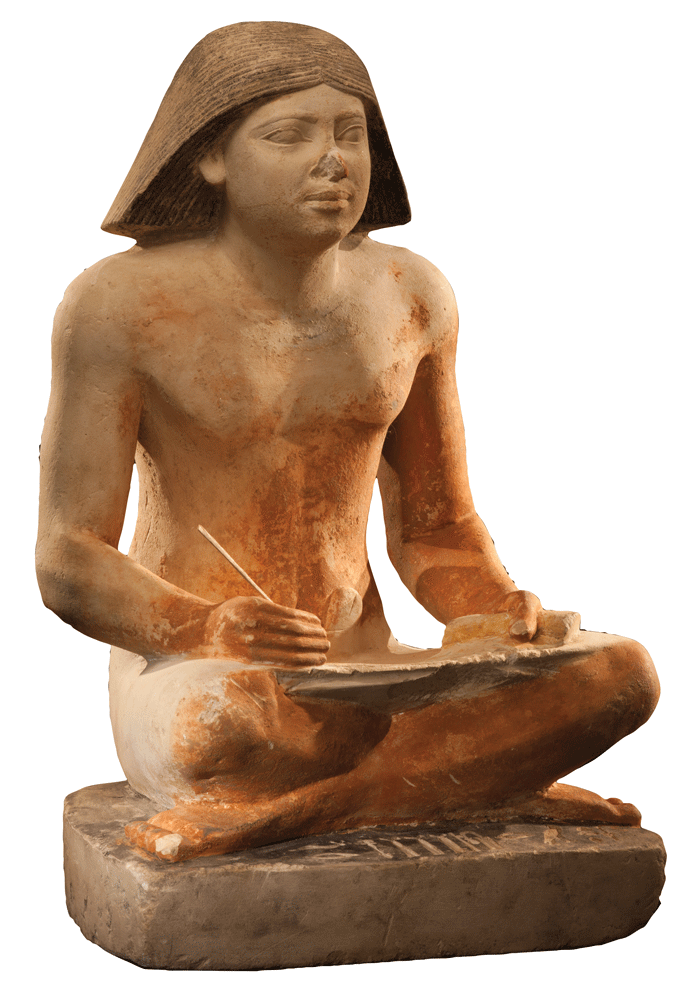 Recent discoveries made by Bárta’s team in Abusir and nearby Saqqara are providing a new look at this period, when a radical shift in political organization transformed the face of the Egyptian monarchy. It was also a time that witnessed an efflorescence of new styles of art and saw the rise of the cult of Osiris, the god of the dead. The 5th Dynasty pharaohs closely identified themselves with the sun god Ra, and controlled worship of the deity. But veneration of Osiris was not overseen by the pharaohs and was available to all who worshipped the god in the proper manner. Osiris ruled over a netherworld that contained not just the pharaoh’s soul, but the souls of all Egyptians. “We can call this a process of ‘democratization’ or widening participation in sacred affairs,” says Bárta. “It was a new way to balance power.”
Recent discoveries made by Bárta’s team in Abusir and nearby Saqqara are providing a new look at this period, when a radical shift in political organization transformed the face of the Egyptian monarchy. It was also a time that witnessed an efflorescence of new styles of art and saw the rise of the cult of Osiris, the god of the dead. The 5th Dynasty pharaohs closely identified themselves with the sun god Ra, and controlled worship of the deity. But veneration of Osiris was not overseen by the pharaohs and was available to all who worshipped the god in the proper manner. Osiris ruled over a netherworld that contained not just the pharaoh’s soul, but the souls of all Egyptians. “We can call this a process of ‘democratization’ or widening participation in sacred affairs,” says Bárta. “It was a new way to balance power.”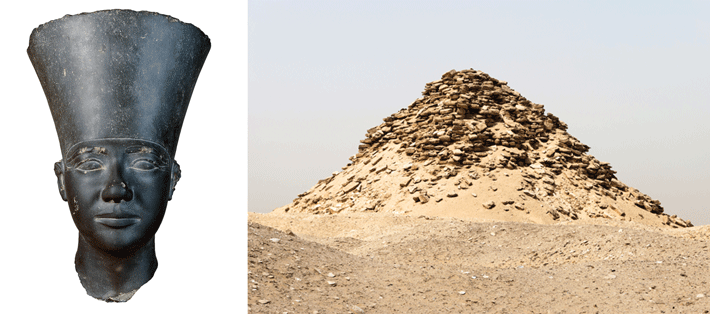 The dynasty’s founder, Userkaf (r. ca. 2465–2458 B.C.), also instituted the practice of building solar temples, elaborate complexes centered around obelisks. These were dedicated to Ra and linked the pharaoh’s authority to the sun god’s supremacy. And there is some evidence in later texts that the 5th Dynasty pharaohs had good reason to cement their legitimacy. A Middle Kingdom (ca. 2030–1640 B.C.) document known as the Westcar Papyrus suggests the 5th Dynasty rulers may have come at least in part from non-royal origins, making them keen to prove their bona fides as deities on Earth. The story recounted in this document is that the first two 5th Dynasty pharaohs, Userkaf and Sahure (r. ca. 2458–2446 B.C.) were sons of the god Ra. Because their royal lineage isn’t mentioned, some scholars have inferred they were not of royal stock, which would have made their connection to Ra even more important in asserting their powers as gods on Earth. All the kings of the 5th Dynasty but one took regnal names that linked their power to Ra, testifying to their special connection to the god of the sun.
The dynasty’s founder, Userkaf (r. ca. 2465–2458 B.C.), also instituted the practice of building solar temples, elaborate complexes centered around obelisks. These were dedicated to Ra and linked the pharaoh’s authority to the sun god’s supremacy. And there is some evidence in later texts that the 5th Dynasty pharaohs had good reason to cement their legitimacy. A Middle Kingdom (ca. 2030–1640 B.C.) document known as the Westcar Papyrus suggests the 5th Dynasty rulers may have come at least in part from non-royal origins, making them keen to prove their bona fides as deities on Earth. The story recounted in this document is that the first two 5th Dynasty pharaohs, Userkaf and Sahure (r. ca. 2458–2446 B.C.) were sons of the god Ra. Because their royal lineage isn’t mentioned, some scholars have inferred they were not of royal stock, which would have made their connection to Ra even more important in asserting their powers as gods on Earth. All the kings of the 5th Dynasty but one took regnal names that linked their power to Ra, testifying to their special connection to the god of the sun.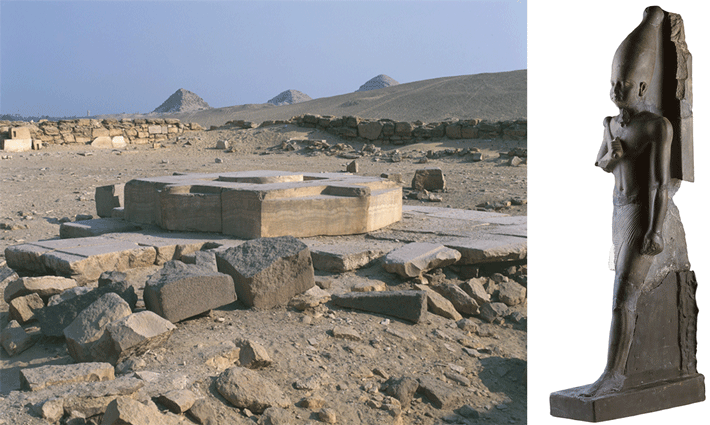 A total of six solar temples were built during the 5th Dynasty. Offerings for all the royal mortuary complexes were first taken to these temples, where they were “solarized,” or exposed to the sun for a set period of time to absorb its power. The sun temple of the 5th Dynasty pharaoh Niuserre (r. ca. 2420–2389 B.C.) lies just north of the necropolis of Abusir and had extensive storage facilities for these sacred gifts, which could include everything from food to furniture. “Rich and varied offerings flowed from the residence of the king to the solar temples and from there to individual mortuary temples where, after they were symbolically offered on altars, they were used as payments in kind to different ranks of officials,” says Bárta. “In a situation when more and more non-royal officials started to occupy even the highest positions in the state administration, this enabled the king to maintain some control of the country’s resources.”
A total of six solar temples were built during the 5th Dynasty. Offerings for all the royal mortuary complexes were first taken to these temples, where they were “solarized,” or exposed to the sun for a set period of time to absorb its power. The sun temple of the 5th Dynasty pharaoh Niuserre (r. ca. 2420–2389 B.C.) lies just north of the necropolis of Abusir and had extensive storage facilities for these sacred gifts, which could include everything from food to furniture. “Rich and varied offerings flowed from the residence of the king to the solar temples and from there to individual mortuary temples where, after they were symbolically offered on altars, they were used as payments in kind to different ranks of officials,” says Bárta. “In a situation when more and more non-royal officials started to occupy even the highest positions in the state administration, this enabled the king to maintain some control of the country’s resources.”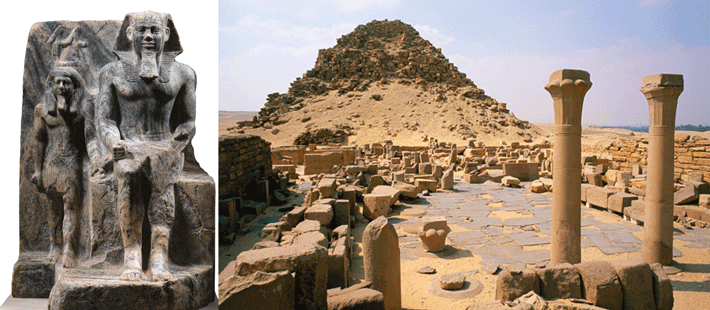 During the 3rd and 4th Dynasties, political power in Egypt had been centralized in Memphis in the person of the pharaoh and his family members. But from the beginning of the 5th Dynasty, high-, mid-, and even low-level officials seem to have been granted unprecedented levels of authority and income. By the reign of Niuserre, an official named Ty, whose titles included King’s Hairdresser, was buried in a monumental, multiroom, richly decorated complex in Saqqara that was first excavated in the late nineteenth century. Large reliefs in the tomb depict at least 1,800 people, mainly priests, but also farmers, hunters, and other common people going about their daily life and providing services to Ty and his family. The tomb embodies the social changes that were accelerating during Niuserre’s reign. Expensive non-royal tombs and the appearance of family tombs at Abusir during this period show that new networks of power, likened by Bárta to those of nepotistic organized crime families, were beginning to compete with royal authority.
During the 3rd and 4th Dynasties, political power in Egypt had been centralized in Memphis in the person of the pharaoh and his family members. But from the beginning of the 5th Dynasty, high-, mid-, and even low-level officials seem to have been granted unprecedented levels of authority and income. By the reign of Niuserre, an official named Ty, whose titles included King’s Hairdresser, was buried in a monumental, multiroom, richly decorated complex in Saqqara that was first excavated in the late nineteenth century. Large reliefs in the tomb depict at least 1,800 people, mainly priests, but also farmers, hunters, and other common people going about their daily life and providing services to Ty and his family. The tomb embodies the social changes that were accelerating during Niuserre’s reign. Expensive non-royal tombs and the appearance of family tombs at Abusir during this period show that new networks of power, likened by Bárta to those of nepotistic organized crime families, were beginning to compete with royal authority.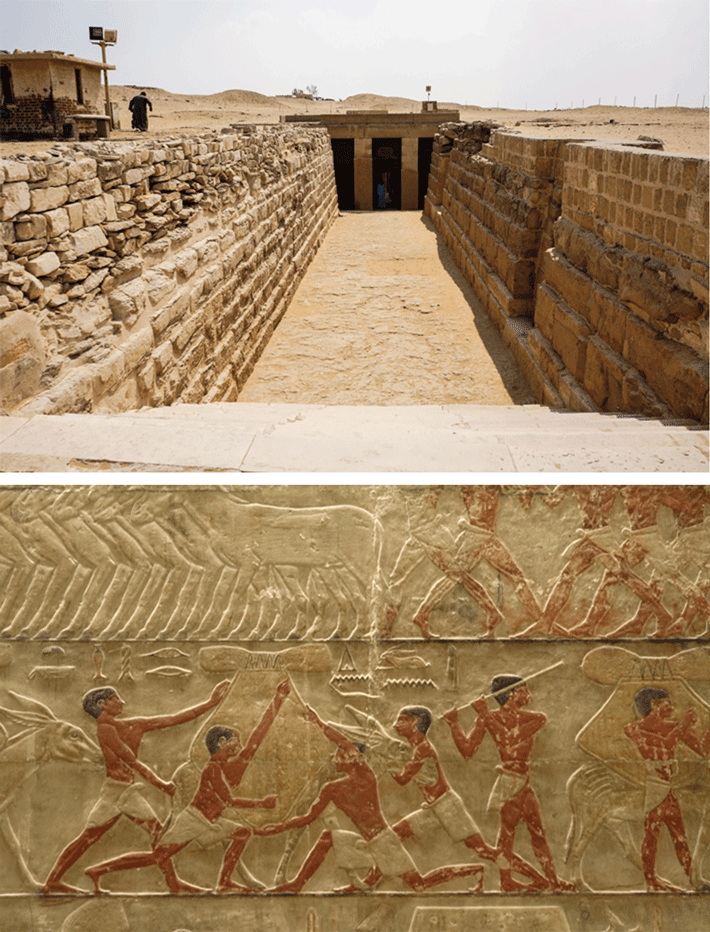 The reign of Niuserre was also the period when Osiris, the lord of the netherworld, was mentioned for the first time. Hieroglyphic inscriptions praising the god have been discovered in the tombs of officials in Abusir and Saqqara. He was first invoked as an important deity in texts discovered in a tomb at Saqqara belonging to an official named Ptahshepses, who served Userkaf and died during the reign of Niuserre. The official’s son, also named Ptahshepses, was Niuserre’s son-in-law. The younger man’s many titles included Privy to the Secret of the House of Morning and Overseer of All Works of the King. He seems to have been the first vizier whose power came close to equaling that of the pharaoh, and his many functions and titles were passed on to his descendants. In fact, his funerary monument in Abusir was more spectacular than the tombs of members of the royal family and rose in pride of place in front of the pyramids of Sahure and Niuserre. No hieroglyphs have been discovered in the tomb of the younger Ptahshepses acclaiming Osiris as the king of the dead, but it is likely that, just as his father had been, he was loyal not only to the pharaoh on Earth, but to the pharaoh in the next world as well.
The reign of Niuserre was also the period when Osiris, the lord of the netherworld, was mentioned for the first time. Hieroglyphic inscriptions praising the god have been discovered in the tombs of officials in Abusir and Saqqara. He was first invoked as an important deity in texts discovered in a tomb at Saqqara belonging to an official named Ptahshepses, who served Userkaf and died during the reign of Niuserre. The official’s son, also named Ptahshepses, was Niuserre’s son-in-law. The younger man’s many titles included Privy to the Secret of the House of Morning and Overseer of All Works of the King. He seems to have been the first vizier whose power came close to equaling that of the pharaoh, and his many functions and titles were passed on to his descendants. In fact, his funerary monument in Abusir was more spectacular than the tombs of members of the royal family and rose in pride of place in front of the pyramids of Sahure and Niuserre. No hieroglyphs have been discovered in the tomb of the younger Ptahshepses acclaiming Osiris as the king of the dead, but it is likely that, just as his father had been, he was loyal not only to the pharaoh on Earth, but to the pharaoh in the next world as well.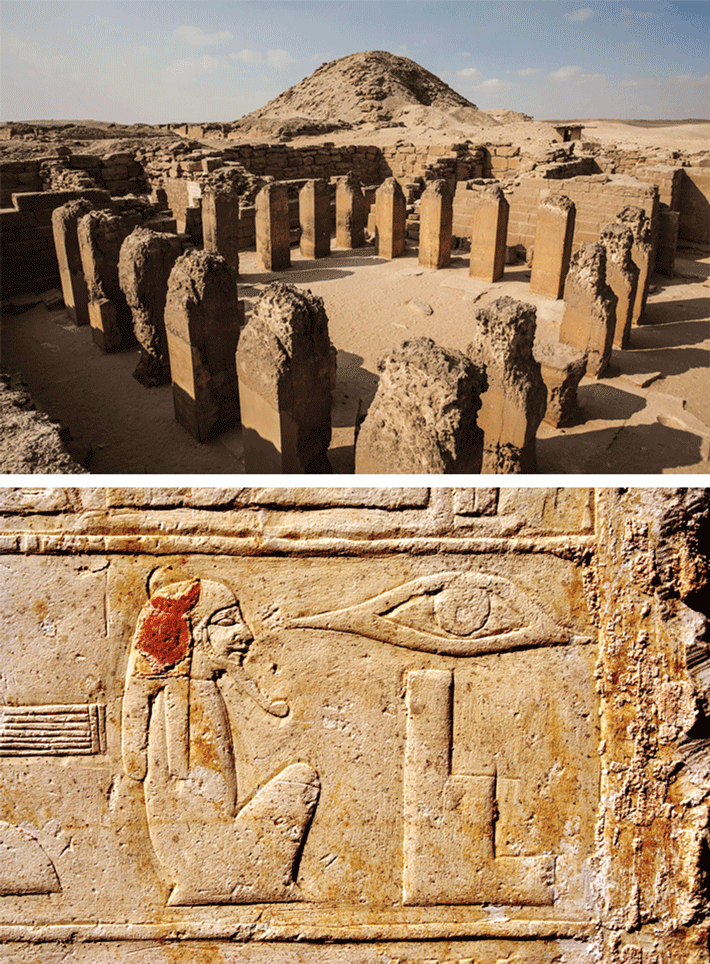 A host of smaller, but nonetheless dramatic, monuments in Abusir and Saqqara also chart the changes that transformed Egypt during the 5th Dynasty. “These are kind of time capsules,” says Bárta. “They are badly known and poorly explored entities in Abusir and Saqqara that are, however, of significance in filling in our knowledge of this critical era in Egypt’s history.” Bárta’s colleague Veronika Dulikova has conducted extensive analysis of the names and titles of officials buried in the cemeteries. This has enabled her to partially reconstruct a complicated network of family ties that kept the 5th Dynasty government functioning. These families constituted what Bárta only half-jokingly refers to as “the world’s first deep state.”
A host of smaller, but nonetheless dramatic, monuments in Abusir and Saqqara also chart the changes that transformed Egypt during the 5th Dynasty. “These are kind of time capsules,” says Bárta. “They are badly known and poorly explored entities in Abusir and Saqqara that are, however, of significance in filling in our knowledge of this critical era in Egypt’s history.” Bárta’s colleague Veronika Dulikova has conducted extensive analysis of the names and titles of officials buried in the cemeteries. This has enabled her to partially reconstruct a complicated network of family ties that kept the 5th Dynasty government functioning. These families constituted what Bárta only half-jokingly refers to as “the world’s first deep state.”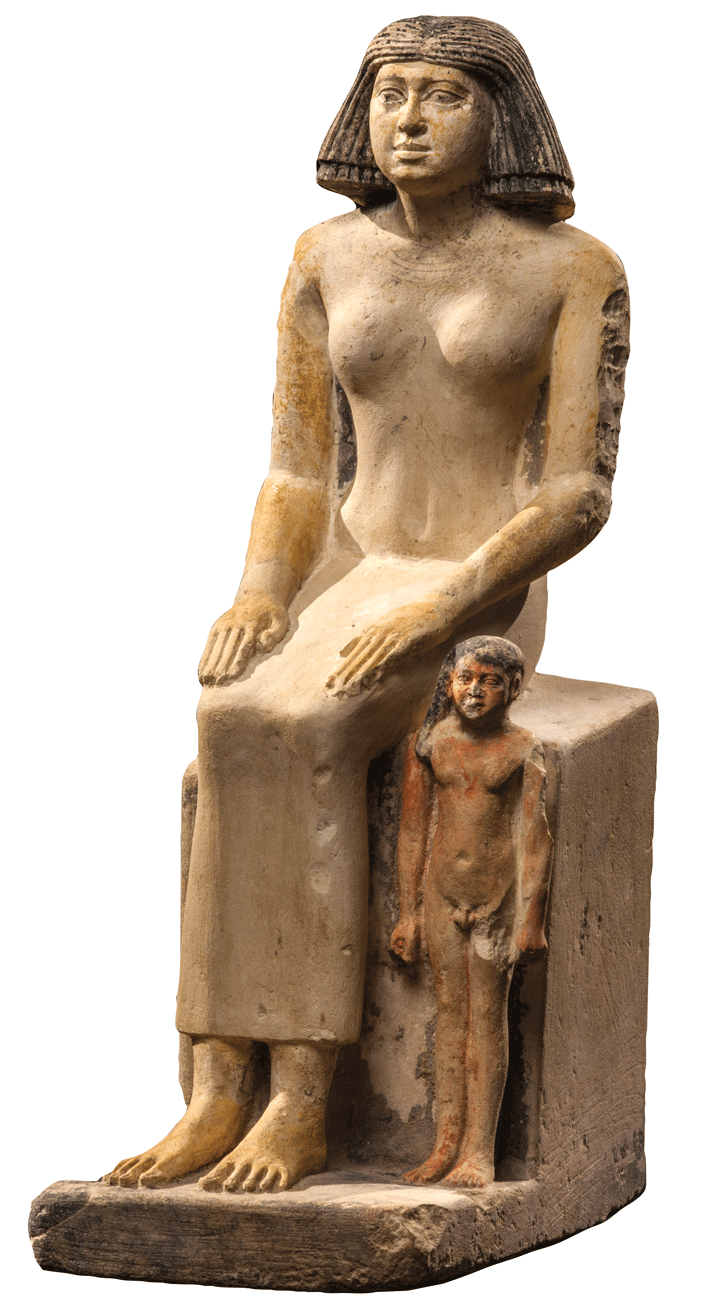 In 2012, his team unearthed the rock-cut tomb complex of Niuserre’s daughter Sheretnebty in the Shepseskafankh cemetery. They were surprised to find the tomb of a princess located so far from her father’s pyramid, where her sisters were buried. Instead, her tomb was built next to that of her husband, an important non-royal official whose name is lost, but who must have been related to the Shepseskafankh family. Inside the tomb, the team discovered limestone statues of Sheretnebty and her husband, along with his elegantly crafted limestone sarcophagus. Bárta notes that despite the man’s evident influence, men of his station rarely married members of the royal family. “This shows that the king used the marriages of his daughters as a means of controlling the rising independence of powerful families,” he says.
In 2012, his team unearthed the rock-cut tomb complex of Niuserre’s daughter Sheretnebty in the Shepseskafankh cemetery. They were surprised to find the tomb of a princess located so far from her father’s pyramid, where her sisters were buried. Instead, her tomb was built next to that of her husband, an important non-royal official whose name is lost, but who must have been related to the Shepseskafankh family. Inside the tomb, the team discovered limestone statues of Sheretnebty and her husband, along with his elegantly crafted limestone sarcophagus. Bárta notes that despite the man’s evident influence, men of his station rarely married members of the royal family. “This shows that the king used the marriages of his daughters as a means of controlling the rising independence of powerful families,” he says.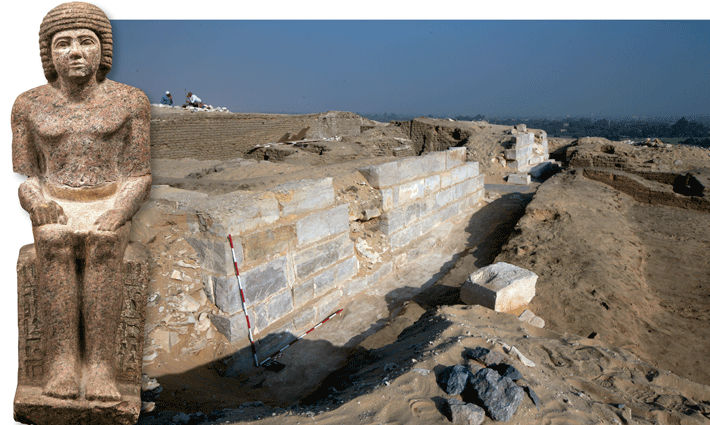
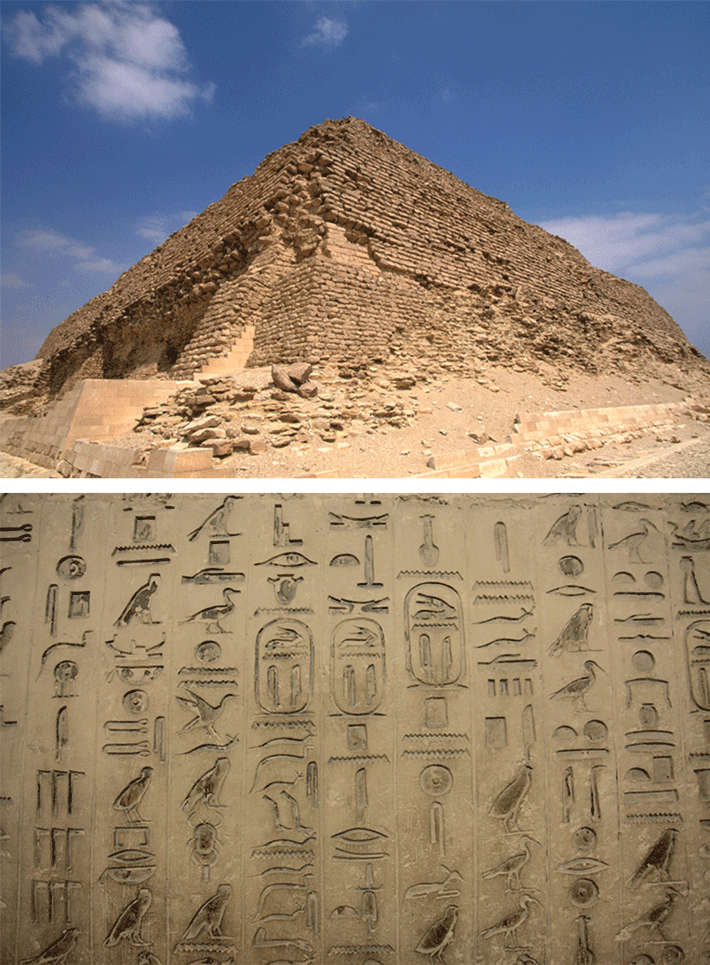 As more non-royal families ascended to power in Memphis, the system of local governorships that existed throughout Egypt also grew in importance. These governorships had largely been figureheads during the reigns of earlier pharaohs, but during the 5th Dynasty, it seems that the people who held these offices actually lived in their designated provinces, instead of ruling them from Memphis, as had previously been the norm. As the governors became more autonomous, increasing political and climatic instability after the end of the 6th Dynasty led to the fall of the Old Kingdom and the beginning of a period of political fragmentation known by scholars as the First Intermediate Period (ca. 2150–2030 B.C.). “The seeds of this period of disorder were planted during the 5th Dynasty,” says Bárta. “Any civilization dissolves when its system of values, symbols, and communication disappears. But this collapse did not necessary imply an end.” When pharaohs once again consolidated some centralized power after the First Intermediate Period, non-royal families still wielded great influence and Osiris continued to reign as the god of an underworld where the souls of all Egyptians dwelled. While the mighty pyramids of Giza remained powerful symbols of the Old Kingdom, the fundamental social and religious changes ushered in during the 5th Dynasty would continue to shape Egypt long into the future.
As more non-royal families ascended to power in Memphis, the system of local governorships that existed throughout Egypt also grew in importance. These governorships had largely been figureheads during the reigns of earlier pharaohs, but during the 5th Dynasty, it seems that the people who held these offices actually lived in their designated provinces, instead of ruling them from Memphis, as had previously been the norm. As the governors became more autonomous, increasing political and climatic instability after the end of the 6th Dynasty led to the fall of the Old Kingdom and the beginning of a period of political fragmentation known by scholars as the First Intermediate Period (ca. 2150–2030 B.C.). “The seeds of this period of disorder were planted during the 5th Dynasty,” says Bárta. “Any civilization dissolves when its system of values, symbols, and communication disappears. But this collapse did not necessary imply an end.” When pharaohs once again consolidated some centralized power after the First Intermediate Period, non-royal families still wielded great influence and Osiris continued to reign as the god of an underworld where the souls of all Egyptians dwelled. While the mighty pyramids of Giza remained powerful symbols of the Old Kingdom, the fundamental social and religious changes ushered in during the 5th Dynasty would continue to shape Egypt long into the future.
